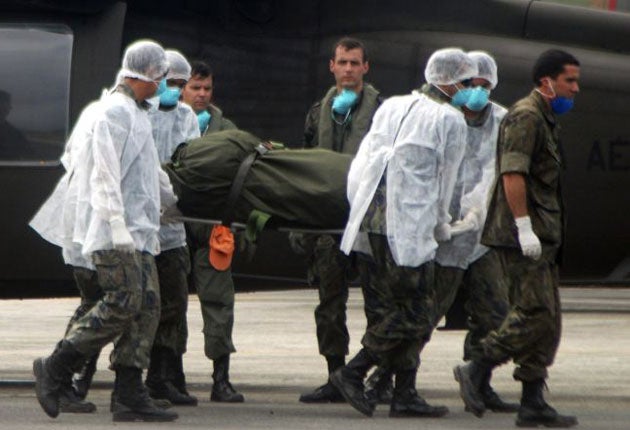Air crash autopsies rule out terrorism

Autopsies on the bodies recovered after the Airbus disaster in the south Atlantic suggest there was no explosion or fire and therefore no terrorist attack.
But two weeks after Air France’s AF447 fell from the sky between the Brazilian and West African coasts, the mystery of what happened to the plane and the 228 people on board remains largely impenetrable.
The automatic messages sent from the aircraft in its dying minutes suggest problems with speed sensors, and also with the rudder in the tail. However, French investigators are still uncertain whether these were symptoms, or the principal causes, of the difficulties which overwhelmed the Airbus 330-200 flying from Rio to Paris on the night of 31 May and 1 June.
Autopsy reports on the first 16 bodies recovered from the ocean seem finally to have put to rest the theory that the aircraft was the victim of a terrorist attack. Details of the autopsies leaked to the Brazilian press at the weekend indicate that the bodies showed no sign of burning or damage from an explosion. The bodies were recovered whole, which is also said to be unusual after a mid-air explosion. Examination by X-ray revealed no evidence that the bodies had been penetrated by shards of metal.
The 50 corpses discovered so far were recovered in two groups over 50 miles apart. This suggests to some aviation experts that the aircraft may have disintegrated, fully or partially, in mid-air.
An aviation website, EuroCockpit, has also published the full details of the 24 automatic messages transmitted by the airbus to Air France headquarters in the minutes before it crashed. Much of this information – including the fact that the aircraft was transmitting erratic and conflicting speed recordings – had already been revealed.
The full details of the messages also show, however, that the aircraft may have had a problem with its “rudder limiter”, which prevents the main rudder, or steering device, in the tail from moving beyond its safe range. Aviation experts said that, in theory, if the rudder moved too far at speed, it could break off and take the “vertical stabiliser” – or main part of the tailplane – with it. The tailplane is the largest piece of wreckage from the A330-200 to have been recovered so far. However, the experts also point out that there was nothing in the automatic message which proved that the “rudder limiter” had failed, causing the crash.
The device might have simply locked itself into place because of the conflicting speed readings. “The message tells us that the rudder limiter was inoperative,” Jack Casey, an aviation safety expert in Washington told the Associated Press.
“It does not give you any reason why it is not working or what caused it, or what came afterward.”
It is believed that the erratic speed readings may have been caused by malfunctioning speed sensors – or pitot tubes – but it still remains unclear how this problem alone could have destroyed, or brought down, a modern aircraft so rapidly. No Mayday call or emergency radio message was sent by the pilot and co-pilot, suggesting that the aircraft fell apart or crashed while they were still going through their first, emergency response procedures.
A French nuclear submarine is searching the ocean depths up to 15,000ft below the crash site in the hope of picking up a message from the beacons fitted to the aircraft’s flight recorders. Senior French air crash investigation officials have warned that it may never be possible to explain the crash unless the recorders or “black boxes” are found. The location “pings” sent out by the boxes will cease in about two weeks’ time.
Join our commenting forum
Join thought-provoking conversations, follow other Independent readers and see their replies
Comments